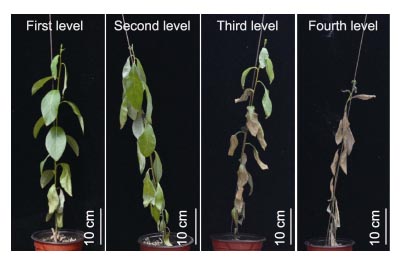

Comparative Study on the Drought Resistance of Young Seedling from Populus laurifolia × P. simonii F1 Progeny
Received date: 2022-04-23
Accepted date: 2022-06-16
Online published: 2022-07-17

Key words: poplar; hybrid; seedling stage; drought resistance; evaluation
Lei Zhang, Pengfei Jiang, Yiming Wang, Ting Lan, Yanjing Liu, Qingyin Zeng . Comparative Study on the Drought Resistance of Young Seedling from Populus laurifolia × P. simonii F1 Progeny[J]. Chinese Bulletin of Botany, 2023 , 58(4) : 519 -534 . DOI: 10.11983/CBB22086
| [1] | 陈章水 (2014). 东北华北关中地区杨树栽培新技术. 北京: 金盾出版社. pp. 57-58. |
| [2] | 冯冬霞, 施生锦 (2005). 叶面积测定方法的研究效果初报. 中国农学通报 21(6), 4. |
| [3] | 付士磊, 周永斌, 何兴元, 陈玮 (2006). 干旱胁迫对杨树光合生理指标的影响. 应用生态学报 17, 2016-2019. |
| [4] | 姬慧娟 (2015). 丹红杨与小叶杨杂交子代苗期抗旱相关性状遗传分析. 硕士论文. 北京: 中国林业科学研究院. pp. 20-21. |
| [5] | 刘增兵, 姜景彬, 杨欢欢, 姜秀明, 李景富 (2019). 植物杂种优势的研究进展. 分子植物育种 17, 4127-4134. |
| [6] | 潘静, 韩蕾 (2017). 葡萄叶片叶绿素含量测定方法比较. 西北园艺 (6), 58-60. |
| [7] | 山仑, 邓西平, 康绍忠 (2002). 我国半干旱地区农业用水现状及发展方向. 水利学报 33(9), 27-31. |
| [8] | 孙佩, 姬慧娟, 张亚红, 贾会霞, 胡建军 (2019). 丹红杨×通辽1号杨杂交子代苗期抗旱性初步评价. 植物遗传资源学报 20, 297-308. |
| [9] | 《新疆植物志》编写委员会 (2019). 新疆植物志(第1卷). 乌鲁木齐: 新疆科学技术出版社. pp. 170. |
| [10] | 徐虎智, 孟丙南, 李云, 王先保, 吕保聚, 程新林, 梁润峰 (2006). 影响林木扦插成活率的因素分析. 河南林业科技 26(3), 26-27. |
| [11] | 张龙进, 李桂双, 白成科, 文苗苗, 张志勤 (2012). 山茱萸种质资源数量性状评价及相关性分析. 植物遗传资源学报 13, 655-659. |
| [12] | Ennajeh M, Vadel AM, Cochard H, Khemira H (2010). Comparative impacts of water stress on the leaf anatomy of a drought-resistant and a drought-sensitive olive cultivar. J Hortic Sci Biotechnol 85, 289-294. |
| [13] | Farooq M, Hussain M, Wahid A, Siddique KHM (2012). Drought stress in plants:an overview. In: Aroca R, ed. Plant Responses to Drought Stress: From Morphological to Molecular Features. Berlin: Springer-Verlag. pp. 1-8. |
| [14] | Farooq M, Wahid A, Kobayashi N, Fujita D, Basra SMA (2009). Plant drought stress: effects, mechanisms and management. Agron Sustain Dev 29, 185-212. |
| [15] | Farquhar GD, Sharkey TD (1982). Stomatal conductance and photosynthesis. Annu Rev Plant Physiol 33, 317-345. |
| [16] | Fathi A, Tari DB (2016). Effect of drought stress and its mechanism in plants. Int J Life Sci 10, 1-6. |
| [17] | Li S, Lin YCJ, Wang PY, Zhang BF, Li M, Chen S, Shi R, Tunlaya-Anukit S, Liu XY, Wang ZF, Dai XF, Yu J, Zhou CG, Liu BG, Wang JP, Chiang VL, Li W (2019). The AREB1 transcription factor influences histone acetylation to regulate drought responses and tolerance in Populus trichocarpa. Plant Cell 31, 663-686. |
| [18] | Lian CL, Li Q, Yao K, Zhang Y, Meng S, Yin WL, Xia XL (2018). Populus trichocarpa PtNF-YA9, a multifunctional transcription factor, regulates seed germination, abiotic stress, plant growth and development in Arabidopsis. Front Plant Sci 9, 954. |
| [19] | Meng S, Cao Y, Li HG, Bian Z, Wang DL, Lian CL, Yin WL, Xia XL (2019). PeSHN1 regulates water-use efficiency and drought tolerance by modulating wax biosynthesis in poplar. Tree Physiol 39, 1371-1386. |
| [20] | Orchard KA, Cernusak LA, Hutley LB (2010). Photosynthesis and water-use efficiency of seedlings from northern Australian monsoon forest, savanna and swamp habitats grown in a common garden. Funct Plant Biol 37, 1050-1060. |
| [21] | Ulrich K, Ewald D (2014). Breeding triploid aspen and poplar clones for biomass production. Silvae Genet 63, 47-58. |
| [22] | Vanlerberghe GC, Martyn GD, Dahal K (2016). Alternative oxidase: a respiratory electron transport chain pathway essential for maintaining photosynthetic performance during drought stress. Physiol Plant 157, 322-337. |
| [23] | Walter J, Nagy L, Hein R, Rascher U, Beierkuhnlein C, Willner E, Jentsch A (2011). Do plants remember drought? Hints towards a drought-memory in grasses. En- viron Exp Bot 71, 34-40. |
| [24] | Yang YL, Li HG, Wang J, Wang HL, He F, Su YY, Zhang Y, Feng CH, Niu MX, Li ZH, Liu C, Yin WL, Xia XL (2020). ABF3 enhances drought tolerance via promoting ABA- induced stomatal closure by directly regulating ADF5 in Populus euphratica. J Exp Bot 71, 7270-7285. |
| [25] | Yu DD, Wildhagen H, Tylewicz S, Miskolczi PC, Bhalerao RP, Polle A (2019). Abscisic acid signaling mediates biomass trade-off and allocation in poplar. New Phytol 223, 1192-1203. |
| [26] | Zhu JK (2016). Abiotic stress signaling and responses in plants. Cell 167, 313-324. |
/
| 〈 |
|
〉 |